How the Dutch Do Winter Bike Lane Maintenance
12:00 PM EST on March 2, 2021
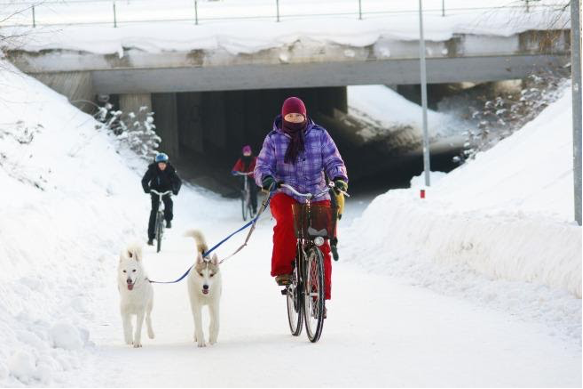
A cyclist is calmly cycling down a well-maintained path with her two dogs. (source: Pekka Tahkola)
Growing up in Canada, winter cyclists were few and far between. Admittedly, I too was a seasonal rider. In the past ten years however, winter cycling has become increasingly common in my hometown, especially in the city center. Still, my main association with winter cycling at that time was either hardcore bicycle messengers who looked like they were dressed as though they were preparing for battle, or the increasingly popular “fat bikes” for which a lucky few had the funds to invest and the space to store them.
When I moved to the Netherlands in 2016 for graduate studies, I realized that winter cycling could be different. Of course, the Netherlands gets nowhere near as much snow or is as cold as most Canadian cities. Dutch winters are instead mainly characterized by wind and rain, and lots of it, but for the most part, this scarcely stops the Dutchies from hopping on their fiets (Dutch for “bikes”) to get to where they need to go.
Having worked with both European and North American clients, many consider the CROW “Design Manual for Bicycle Traffic” as the bible of Dutch cycling design. Many cities look to this manual as one of the guides on cycling infrastructure design, but once they seek to implement any of its recommendations, they throw in the towel when confronted with winter conditions.
In the first few months as a consultant, one of my colleagues suggested I take a good look at the CROW’s winter maintenance manual. I thought, “Sure, get the Canadian guy to read about winter road maintenance. I get it…” Needless to say, like many manuals, it was a rather dry read, full of tables, figures, and more information on salts and brines that I will ever need or want to know. Despite the heavy content, it did contain some valuable lessons about winter maintenance for bicycle infrastructure.
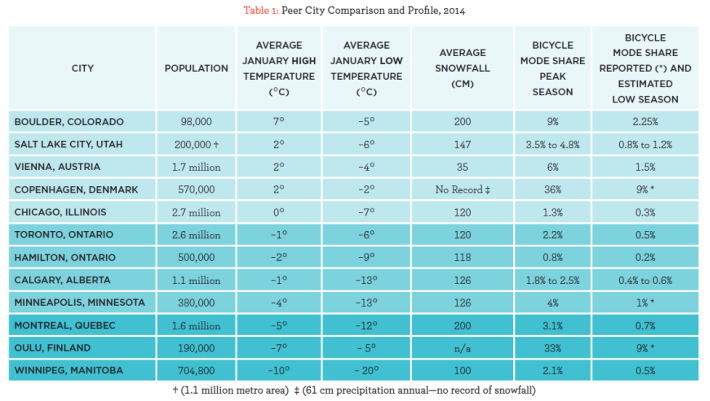
It should be noted that “winter cycling” means something different depending where you are on the globe. A winter in Barcelona is hard to compare to one in Chicago, Vienna, Minneapolis, or Montreal. Even among these snowier cities, average temperatures, type and volumes of precipitation vary. With this in mind, what is described below is primarily targeted at cities with snowfall, regardless of these differences.
Prioritizing networks
To start, I have to disappoint the engineers among us. As much as it might be fun to nerd-out on turning radii, surfacing materials and curb heights, achieving Dutch-like cycling infrastructure in winter cities has very little to do with design. You cannot design snow away. In fact, while there might be a few considerations to keep in mind, designing cycling infrastructure for winter cities is not all that different than that for cities that are a balmy 25°C/77°F year-round. Achieving a winter cycling city is instead much more about setting priorities.
A crucial element of the CROW’s winter maintenance manual is the emphasis on establishing a prioritized winter maintenance network. Usually a standard practice for the car network, the Dutch also have winter maintenance prioritization networks for their cycling infrastructure. According to the manual, these consists of three levels of priority:
- Level A: This is the highest priority portions of the network and usually make up the most crucial connections within it. These sections are treated under all circumstances.
- Level B: These sections of the network typically form the foundation of the overall cycling network. They are treated under “normal” weather conditions.
- Level C: These are sections of the network that are only treated once all of the B-level routes require no further treatment. These are often peripheral locations such as residential streets and suburbs.
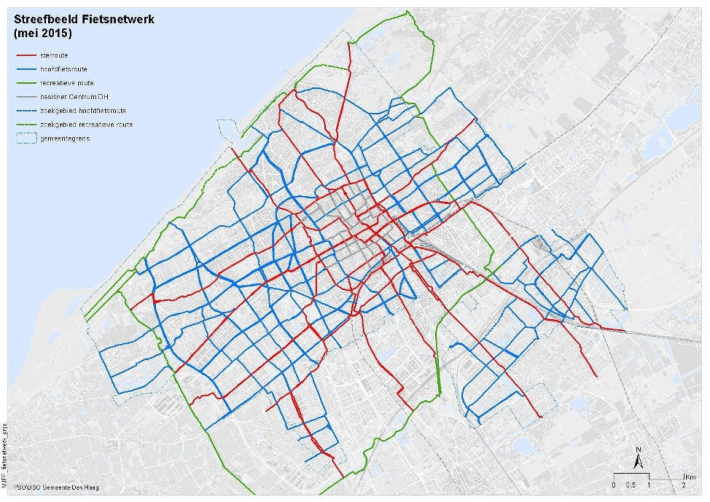
These priority levels can also be treated in three different ways. First, you can take preventative measures, meaning roads are treated in advance of any expected precipitation. This usually involves a salt or brine application. The next is a remedial measure, which is an application applied in response to precipitation that has or to continues to fall. This can include salt and brine treatments, plowing, or a combination of the two. The third is a repeat measure, which means that operators will re-treat the roadway, usually due to prolonged precipitation.
Though not all Dutch municipalities express their priorities in this manner, most have mapped out the hierarchy or “layers’ of their network. This way, their prioritization is ready to go, so when they do need to treat it, the hierarchy of the network itself guides which routes get maintenance priority.
What’s important to keep in mind here is what defines “normal” weather conditions. Of course, this varies from place to place. As we know from Europe’s recent snowfalls, many cities simply don’t plan for 20cm/7.8” of snowfall overnight. However if this is a regular occurrence, as it is many places in North America, Scandinavia, and Asia, then this is normal and is what you should be planning for. There will be snow, every year, and that’s simply something that winter cities have to accept.
Simply having a prioritized network is not enough. The quality of the network itself is of crucial importance. Take the city of Winnipeg, Canada, for instance. The city has three levels of priority. The left image is a portion of the downtown’s winter maintenance prioritization for the car network. Here, the prioritization (noted by the colors) is quite equally distributed throughout the network. However, comparing this to the “active pathways” winter prioritization network on the right, there is a weak diversity of routes. The ones you do see are high priority, but form a patchwork of disconnected routes, rather than an actual network. Though I was not there at the meeting table when the latter network was created, I suspect that it was designed based on the budget, rather than than users’ needs.
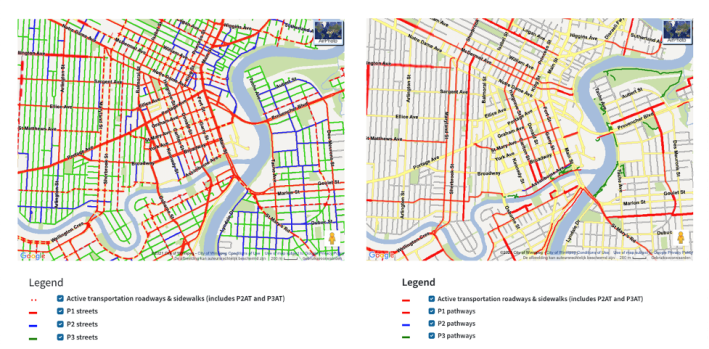
Swallowing the icy cold pill: Winter is expensive
Let’s face it, operating a winter city isn’t cheap. The more snow you get, the more work it is to manage it. This requires equipment and materials, labour to clear it, as well as space to store it, but if snow is a regular occurence (ie. “normal”), why not prioritize for it? However, prioritizing is not just a matter of designing a functional hierarchical cycling network. It’s also a matter of budgeting. If you so much of your network receives A-level priority, you better have the budget to fund it, and if the funds aren’t available to budget for it, getting them should be high on a city’s agenda. Otherwise, a winter network isn’t worth any more than the paper it’s printed on.

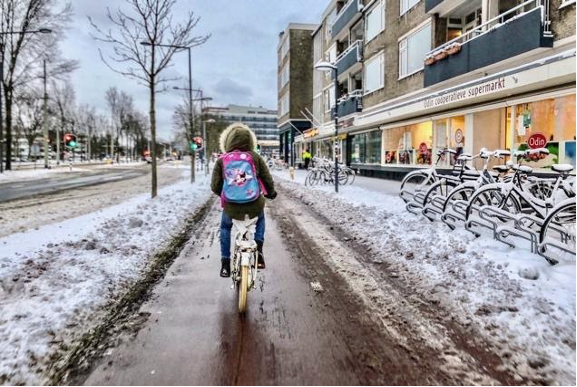
Another common problem is the lack of proper equipment. Not only is there a range of types and sizes of plows, brushes, and snowblowers suitable to maintain the network, the fact that a city has to invest in them is primarily an initial investment. Fortunately narrow bike paths don’t show up overnight, so cities have plenty of time to plan for it. In short, invest in equipment to fit your infrastructure, rather than investing in the infrastructure to fit your equipment.
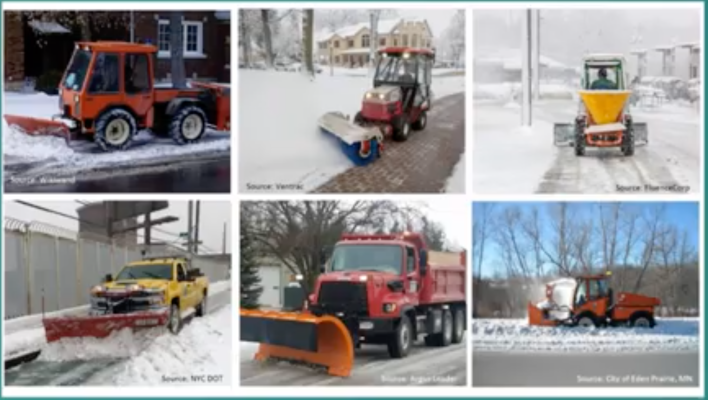
There is little reason for winter to be an impediment to achieving Dutch street design other than budget priorities. If a snowy winter is guaranteed year after year, not budgeting for proper winter maintenance for all modes of transportation, and then using winter as an excuse for not being able to implement high quality bicycle infrastructure is like refusing to buy apples and then complaining you can’t make applesauce.
Implementing a safe and secure cycling network for a winter climate is not without its challenges, but can be addressed with proper planning and resources.
Stephen Kurz is a Mobility Advisor at Mobycon.
Kea Wilson has more than a dozen years experience as a writer telling emotional, urgent and actionable stories that motivate average Americans to get involved in making their cities better places. She is also a novelist, cyclist, and affordable housing advocate. She previously worked at Strong Towns, and currently lives in St. Louis, MO. Kea can be reached at kea@streetsblog.org or on Twitter @streetsblogkea. Please reach out to her with tips and submissions.
Read More:
Stay in touch
Sign up for our free newsletter
More from Streetsblog USA
How Car-Centric Cities Make Caring For Families Stressful — Particularly For Women
Women do a disproportionate share of the care-related travel their households rely on — and car-focused planning isn't making matters easier.
Wednesday’s Headlines Build Green
A new bill dubbed "Build Green" would replace many of the climate-friendly elements Sen. Joe Manchin insisted on stripping from the Inflation Reduction Act.
E-Bikes and Creating Financially Sustainable Bike Share Programs
The number of customers using bike share in the U.S. and Canada is now at an all-time high thanks to e-bikes.
Tuesday’s Headlines Pick the Low-Hanging Fruit
Greg Shill argues that if a transformative road redesign isn't possible, it's time to talk about second-best strategies.
How to Fight a Texas-Sized Freeway Battle
A new book explores how Texas advocates are fighting back against destructive highway expansions. But what happened to those projects since it was sent to the printer?





